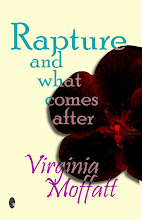I am always looking to tell stories in a
different way, other than those of beginning, middle, ends. So in this my new
collection of flash fiction, I have two stories without characters in them at
all. One is like a landscape painting, but with markers of time passing etched
across its man-made fabric, while the second is delineated by the changes
marking a human body under duress. The final story in the collection doesn’t have any sentences or paragraphs. It is
formed of two columns of single words that can be read either down or across to
determine the relationship of the two distinct voices.
I love playing with language, particularly
drilling down to the DNA of words, that is the very letters that form them. So
in the story “Type-O Negative” a woman is exposed to
radiation, but instead of developing a superpower in comic book tradition, ‘Isotope Girl’s’ words mutate one letter at a time with
hilarious outcomes. In the story “Ur,
Um”, the first human
language from which all others stemmed, the so called urlanguage, is
resurrected when one morning a man wakes up to find he can speak it. Everyone
thinks it sounds familiar to them, but no one can quite understand him. Then
the politicians get involved in laying claim to him…
If there is a theme to most of the stories, it
is that many start from a consideration of the human body. Ageing is a motif,
so that “Staring At The Sun” originates from my
own developing of floaters in the eye, “Nocebo” is all about the difficulty of taking pills and “Nemesis” sees a superhero face his greatest foe, his
body empowered by radiation but also set for mutiny by the radioactive mutation
wrought. “The Idea of A Man” takes three iconic
images of the dead, a body preserved from Pompeii, a Bog Body and a dead
soldier from Desert Storm and probes our fumbling need to deduce their stories
from the fragments they leave behind. We end up imposing narratives and lives
on these people which they in all likelihood never have lived and through that
I question our reflexive urge to form stories.
So there it is. Some among the twenty-eight stories in this my fourth collection of flash fiction, all beautifully presented by Gumbo Press who are also publishing Virginia’s debut flash collection with which I’m delighted to be alongside on the same roster. Virginia, thank you so much for this opportunity to talk about my book and may we both help establish Gumbo press as a really important literary imprint.

No comments:
Post a Comment